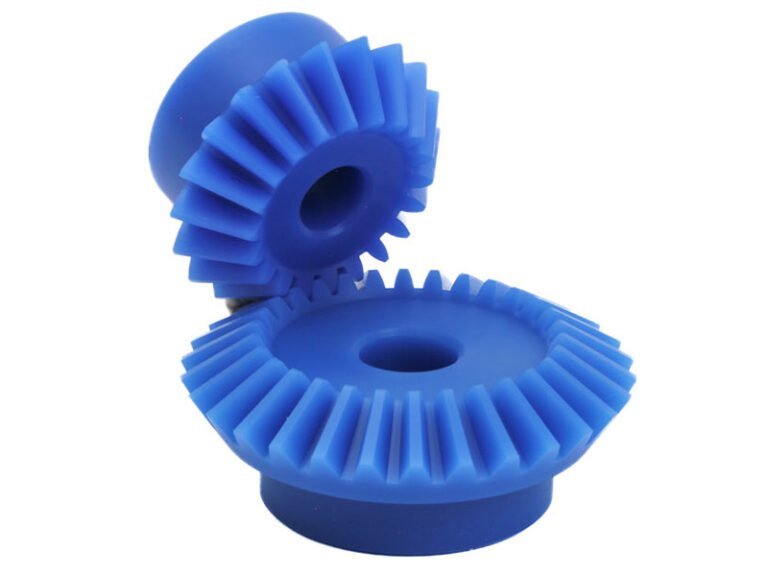The unique design of a worm and gear pair enables high torque multiplication at right angles. Plastic worm gear components are gaining use in light-duty, low-noise, and precision applications. This article covers the definition, structure, operating principles, advantages, and common scenarios for worm gear setups.
What is a Worm Gear?
A worm gear is a type of gear arrangement in which a worm, resembling a screw, meshes with a worm wheel (or gear). The worm has helical threads, and the worm wheel contains teeth that match the thread profile, allowing torque transfer between non-parallel and usually perpendicular shafts.
Worm Gear Materials
Worm gears can be made from metal or plastic. Common metal options include hardened steel, case-hardened alloy for the worm, and bronze, brass, or cast iron for the worm wheel. For plastic options, the wheel can be made from nylon, acetal (POM), or MC nylon, providing lightweight and self-lubricating alternatives.
Worm Gear Types
Worm gears can be classified based on thread and envelope design:
Cylindrical Worms: Straight threads run along a cylinder. Simple design and easy to manufacture.
Single-Enveloping Worms: The worm wheel teeth curve to partially wrap the worm, increasing contact area and load capacity.
Double-Enveloping Worms: Both the worm and the wheel are curved, providing maximum contact and the highest load capacity.
Duplex Worms: Use varying lead angles to allow precise adjustment of backlash.
Non-Throated Worms: Maintain cylindrical shapes for simplicity, easier manufacturing, and lower cost.
Worm Gear Structure and Working Principle
The worm and gear assembly consists of two primary components: the worm and the worm wheel. The worm acts like a screw, while the worm wheel is analogous to a spur gear that meshes along the worm’s helical threads.

Operating Mechanism
Rotation begins at the worm. Each full turn advances the wheel by the number of worm starts. Reduction ratio equals wheel teeth divided by worm starts (e.g., 40:1 for 40-tooth wheel and single-start worm). Contact occurs along a line, progressing from entry to exit. Efficiency ranges from 50-90%, dropping at high ratios due to sliding friction. Low lead angles (under 10°) create self-locking: the wheel cannot drive the worm backward.
Worm Gear Advantages and Disadvantages
Advantages of Worm Gear
- High Reduction Ratio: Single-stage worm gears can achieve significant speed reduction, simplifying gear train design.
- Compact Design: The perpendicular shaft arrangement allows space-saving installations.
- Smooth and Quiet Operation: Gradual engagement reduces vibration and operational gear noise.
- Self-Locking Capability: Certain worm gear setups prevent back-driving, enhancing safety in lifting and positioning applications.
- Lightweight with Plastics: Using plastic worm wheels reduces system weight and manufacturing costs while maintaining adequate performance for light-duty applications.
Disadvantages of Worm Gear
- Lower Efficiency: Friction between the worm and wheel generates heat, leading to energy loss. Efficiency is generally lower than that of spur or helical gears.
- Wear Concerns: Metal worms paired with metal wheels require careful lubrication. Plastic worm wheels can wear faster under high torque or continuous operation.
- Limited Reverse Drive: worm gears are not suitable for bidirectional power.
Common Applications of Worm Gears
Worm gears are widely used across different industries due to their ability to provide high reduction ratios in compact systems, smooth operation, and self-locking features.
Precision Adjustment: Used in automotive seats, mirrors, and medical equipment, worm gears enable smooth, accurate positioning with minimal noise and secure holding.
Power Transmission: In industrial machinery, lifts, and conveyors, they deliver high torque in compact setups, offering reliable motion control under heavy loads.
Compact Motion Control: Consumer electronics such as printers, cameras, and small appliances use plastic worm gears for quiet, lightweight, and efficient movement.
Robotics and Automation: Essential in robotic arms and servo drives, worm gears provide precise motion and built-in stability, preventing back-driving in automated systems.
Heavy-Duty Equipment: In marine, construction, and energy applications, metal worm gears handle demanding loads, absorb shock, and ensure long-term reliability in harsh conditions.
Conclusion
Worm gear systems provide reliable reduction and torque multiplication. With the growing adoption of plastic materials, plastic worm and gear systems provide lightweight, low-noise, and cost-effective alternatives for light to medium load applications. Flexiparts offers custom plastic worm gear solutions with precision molding.



